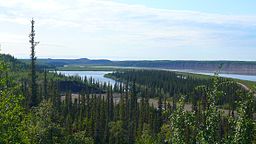Mackenzie river
| Mackenzie River (Deh-Cho, Kuukpak) | |
|
The Mackenzie River in August 2009
|
|
| Name origin: Alexander Mackenzie, explorer | |
| Country | Canada |
|---|---|
| Region | Yukon, Northwest Territories |
| Tributaries | |
| - left | Liard River, Keele River, Arctic Red River, Peel River |
| - right | Great Bear River |
| Cities | Fort Providence, Fort Simpson, Wrigley, Tulita, Norman Wells |
| Source | Great Slave Lake |
| - location | Fort Providence |
| - elevation | 156 m (512 ft) |
| - coordinates | 61°12′15″N 117°22′31″W / 61.20417°N 117.37528°W |
| Mouth | Arctic Ocean |
| - location | Beaufort Sea, Inuvik Region |
| - elevation | 0 m (0 ft) |
| - coordinates | 68°56′23″N 136°10′22″W / 68.93972°N 136.17278°WCoordinates: 68°56′23″N 136°10′22″W / 68.93972°N 136.17278°W |
| Length | 1,738 km (1,080 mi) |
| Basin | 1,805,200 km2 (696,992 sq mi) |
| Discharge | for mouth; max and min at Arctic Red confluence |
| - average | 9,910 m3/s (349,968 cu ft/s) |
| - max | 31,800 m3/s (1,123,000 cu ft/s) |
| - min | 2,130 m3/s (75,220 cu ft/s) |
|
Map of the Mackenzie River watershed
|
|
The Mackenzie River (Slavey language: Deh-Cho, big river or Inuvialuktun: Kuukpak, great river) is the largest and longest river system in Canada, and is exceeded only by the Mississippi River system in North America. It flows through a vast, isolated region of forest and tundra entirely within the country's Yukon and Northwest Territories, although its many tributaries reach into four other Canadian provinces and territories. The river's mainstem runs 1,738 kilometres (1,080 mi) in a northerly direction to the Arctic Ocean, draining a vast area nearly the size of Indonesia. It is the largest river flowing into the Arctic from North America, and with its tributaries is one of the longest rivers in the world.
Rising out of the marshy western end of Great Slave Lake, the Mackenzie River flows generally west-northwest for about 300 km (190 mi), passing the hamlet of Fort Providence. At Fort Simpson it is joined by the Liard River, its largest tributary, then swings towards the Arctic, paralleling the Franklin Mountains as it receives the North Nahanni River. The Keele River enters from the left about 100 km (62 mi) above Tulita, where the Great Bear River joins the Mackenzie. Just before crossing the Arctic Circle, the river passes Norman Wells, then continues northwest to merge with the Arctic Red and Peel rivers. It finally empties into the Beaufort Sea, part of the Arctic Ocean, through the vast Mackenzie Delta.
...
Wikipedia


